More Astronomical Photographs
Michael A. CovingtonAuthor, Astrophotography for the Amateur
http://www.CovingtonInnovations.com/astro
All pictures Copyright 2001, 2002, 2003, 2004 Michael A. Covington.
Contact me for reprint rights and higher-resolution scans.
All of these pictures have been processed digitally in standard ways,
generally with Adobe Photoshop.

The Pleiades star cluster, a perennial favorite. Twenty-minute guided exposure with Nikon 300-mm f/4 lens and didymium filter (undersized, giving a 67 mm aperture, or f/4.5) on "new" Elite Chrome 100 film pushed 1 stop. The reflection nebulosity, consisting of space dust near the star Merope, is clearly visible.

A colorful red auroral curtain in front of Cygnus and Lyra. Same site, date, and technique as the following picture, but 30 seconds at f/1.8. At this point the aurora was faintly visible to the naked eye, perhaps half as bright as the Milky Way, and faintly reddish.
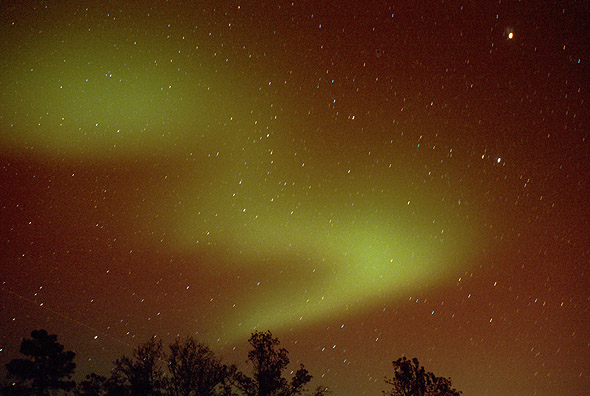
The finest aurora borealis that I've ever seen - and I saw it in Georgia, where auroras are rare. This bright green curtain was photographed from Danielsville (near Athens) on November 20, 2003. One minute at f/2.8 with 50-mm lens on "new" Kodak Elite Chrome 100 (=E100G) pushed 1 stop. Star at upper right is Capella. The aurora was just as spectacular to the eye as to the camera.
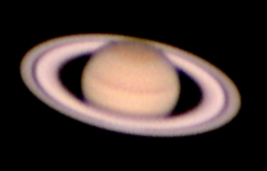
Saturn, photographed with an 8-inch Schmidt-Cassegrain telescope and a Philips ToUCam with the same technique as Mars pictures posted earlier.

A spectacular display of the Aurora Borealis (Northern Lights) in Georgia.
The aurora is a very rare sight here, and this display (caused by one of the sunspots shown below) was a once-in-a-century event. The constellation Perseus is just above center, and the Pleiades are at the lower right. At the bottom is a distant cloud bank probably associated with the Savannah River.
One-minute exposure on Fuji Provia 400F film with a 24-mm f/2.8 lens wide open, with the camera on a fixed tripod.
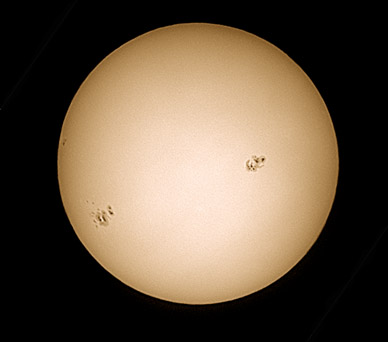
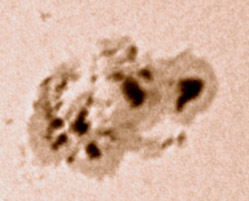
Sunspots photographed on October 25, 2003.
Left: Full-face view of the Sun. Celestron 5 telescope, Baader solar filter, 32-mm eyepiece, and Nikon Coolpix 990 digital camera. At the lower left is the sunspot that ejected the particles that caused the aurora on October 30.
Right: Enlarged view of the upper right sunspot group. Same telescope, 18-mm eyepiece, Nikon Coolpix 990 camera; composite of three exposures sharpened with Registax.

Mars through a cheap webcam.
This was taken with a Philips ToUCam Pro whose lens had been removed and replaced by an eyepiece-tube adapter made for me by Chris Heapy of Macclesfield, Cheshire, England.
8-inch f/10 telescope, 2x Barlow lens. Over 900 video images were captured, and then the best ones were selected, aligned, and processed with Registax 2.
Note Syrtis Major at the left and Sinus Sabaeus in the center. Just below center, nestled in the curve of Sinus Sabaeus, is a light-colored round patch that may be a processing artifact, or may be a blurred image of the crater Schiaparelli. The craters of Mars are not normally visible from Earth, but some of them show up as pale spots.
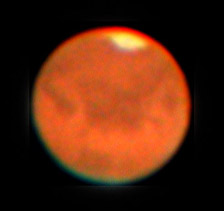

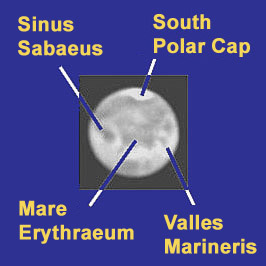
Mars during its unusually close pass to the earth in 2003. Note that you can see Valles Marineris, the Grand Canyon of Mars, which is the only "canal" that corresponds to a definite geographic feature.
TOP: 2003 August 26, about 11:50 p.m. EDT. Composite of 7 images taken with a Nikon Coolpix 990 aimed into the 18-mm eyepiece of an 8-inch f/10 telescope with a Barlow lens.
BOTTOM: About 15 minutes earlier, 11:35 p.m. EDT. Taken with SBIG STV CCD camera, 2x Barlow lens, 23A red filter, and 8-inch f/10 telescope. This is a composite of 6 images each of which was the sharpest of many dozens of video frames examined by the camera in "best sharpness" mode. The composite image was processed with Registax 2. It is a monochrome (black-and-white) image; the red tint was added in Photoshop to help bring out low-contrast detail.
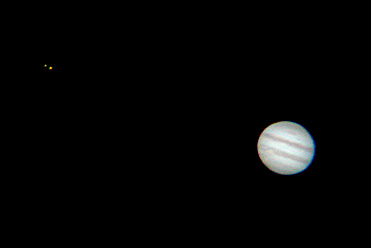
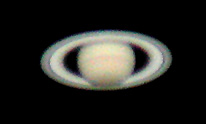
Left: Jupiter with the satellites Ganymede (larger) and Europa.
Right: Saturn with the rings fully open and Cassini's Division well
displayed.
Both were taken with a Nikon Coolpix 990 digital camera and an 8-inch f/10 Schmidt-Cassegrain telescope, linked by a special ScopeTronix 18-mm eyepiece that screws directly into the filter thread of the camera.
When taking a picture this way, the camera is set to infinity focus (mountain symbol); the telescope is focused by looking at the LCD screen on the camera; and the shutter is tripped with the self-timer (time delay) to keep from vibrating the telescope.
I want to thank Jordan Blessing of ScopeTronix for the use of the special eyepiece.
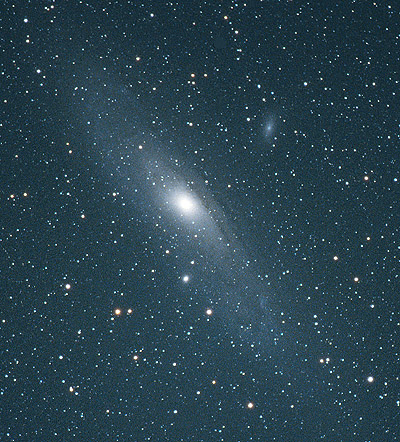
Spiral galaxy M31 (the Andromeda Galaxy). Nikon 300-mm f/4 ED IF AF lens and Nikon F3 body piggybacked on Meade LX200 telescope with SBIG STV autoguider; 30-minute exposure on Kodak Elite Chrome 200 film.
Taken at a dark-sky site in Madison County, Georgia.
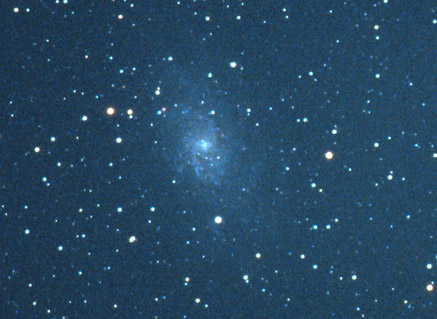
Spiral galaxy M33 in Triangulum. Nikon 300-mm f/4 ED IF AF lens and Nikon F3 body piggybacked on Meade LX200 telescope with SBIG STV autoguider; 15-minute exposure on Kodak Elite Chrome 200 film which had been preflashed to 10% of a mid-gray exposure.
This is an enlarged, digitally enhanced copy of a small part of the original slide.
Note the white-and-pink "double star" to the upper left of center. The pink component is actually the nebula NGC 604, an object similar to the Orion Nebula but larger and located in the galaxy M33.
Taken at a dark-sky site in Madison County, Georgia.

The stars of Scorpius and the star clouds of the galactic center loom above the horizon and the lights of a distant town.
Sigma 24-mm f/2.8 wide-angle lens on Nikon camera body, piggybacked on a motor-driven telescope; 10-minute exposure on Kodak Elite Chrome 200 film.
Taken at the Charlie Elliott Wildlife Center, Mansfield, Georgia.

Star clusters M6 (left), M7 (top), and the emission nebulae NGC 6357 (upper right) and NGC 6334 (lower right).
Ten-minute exposure with a Nikon 180-mm f/2.8 ED IF AF lens on an F3 body, with a didymium filter, on Kodak Elite Chrome 200 film.
Taken at the Charlie Elliott Wildlife Center, Mansfield, Georgia.
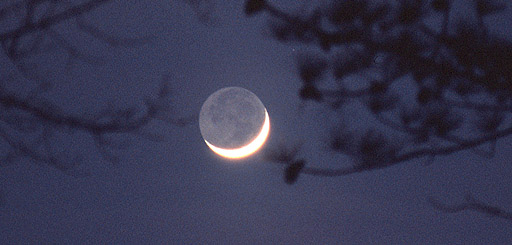
Earthshine. Reflected light from the earth reveals the maria on the unlit side of the moon. Four-second exposure with a 300-mm f/5.6 telephoto lens on Kodak Elite Chrome 200 film; the camera was on a fixed tripod.
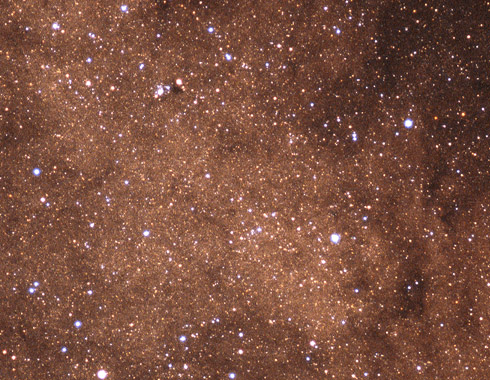
Dark nebulae (clouds of gas that absorb light) trace an intricate pattern in front of the densest part of the Milky Way in Sagittarius. At upper left, the compact, unusually dense nebula Barnard 86 seems to "punch a hole" in our galaxy, right next to the star cluster NGC 6520.
While looking at a similar object (probably not this one), Sir William Herschel was heard to exclaim, "Hier ist wahrhaftig ein Loch im Himmel!" ("Here is surely a hole in the heavens!") He thought that he was looking at a gap in our galaxy through which more distant objects could be seen.
This is part of a larger picture taken with a Nikon 180-mm f/2.8 ED IF AF lens on an F3 body, piggybacked on a motor-driven telescope with autoguider; a 10-minute exposure on Kodak Elite Chrome 200 film with a didymium filter.
Taken at the Charlie Elliott Wildlife Center, Mansfield, Georgia.
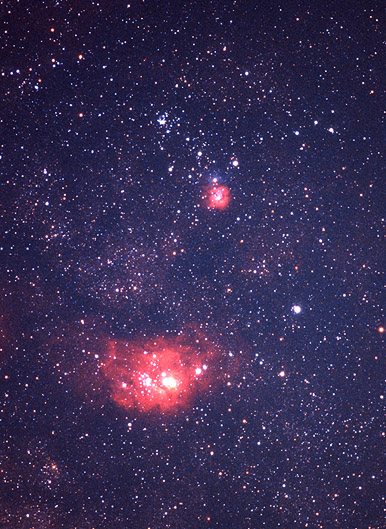
Bottom to top: The Lagoon Nebula (M8), the Trifid Nebula (M20), and the star cluster M21 in Sagittarius.
Nikon F3 with 300-mm f/4 ED IF AF lens piggybacked on a motor-driven telescope with autoguider; 12-minute exposure on Kodak Elite Chrome 200 film with a didymium filter.
Taken at the Charlie Elliott Wildlife Center, Mansfield, Georgia.
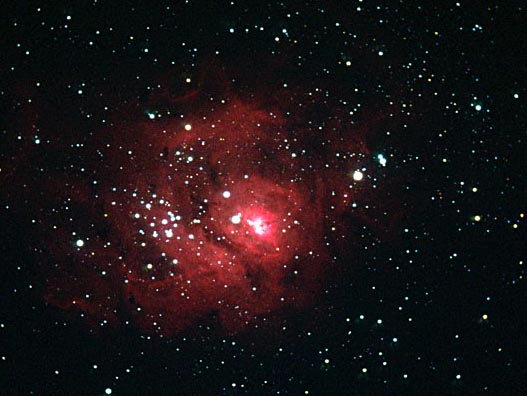
The Lagoon Nebula (M8) in Sagittarius. 12-minute exposure with an 8-inch (20-cm) Schmidt-Cassegrain telescope using a compressor lens at f/5.6 on Kodak Elite Chrome 200 film. Autoguided with an SBIG STV CCD camera.
Taken at the Charlie Elliott Wildlife Center, Mansfield, Georgia.